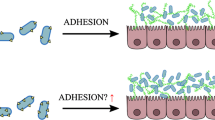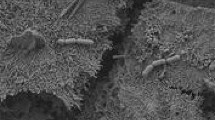Abstract
Mucin-associated microbiota are in relatively close contact with the intestinal epithelium and may thus have a more pronounced effect on host health. We have previously developed a simple mucin agar assay to simulate initial mucus colonization by intestinal microbial communities. Adherence of microbiota was estimated using flow cytometry after detachment with Triton X-100. In this study, the effect of this detergent on the cultivability of both virulent and commensal strains was investigated. Mucin attachment of selected strains was evaluated using the mucin adhesion assay. Bacteria were dislodged from the mucin surface by incubation with Triton or from the whole mucin agar layer using a stomacher. Mechanical extraction resulted in 1.24 ± 0.42, 2.69 ± 0.44, and 1.56 ± 0.85 log CFU/mL higher plate counts of Lactobacillus rhamnosus, Bacillus cereus, and Escherichia coli strains, respectively, than the chemical method. The sensitivity of bacteria to Triton varied among microbial species and strains. Among others, Triton inhibited the growth of Salmonella enterica LMG 10396 and Pseudomonas aeruginosa LMG 8029 on laboratory media, although these bacteria maintained their viability during this treatment. Only Gram-positive strains, Enterococcus hirae LMG 6399 and L. rhamnosus GG, were not affected by this detergent. Therefore, the mechanical method is recommended for the extraction of mucin-adhered bacteria that are sensitive to Triton, especially when followed by traditional cultivation techniques. However, this approach can also be recommended for strains that are not affected by this detergent, because it resulted in higher recovery of adhered L. rhamnosus GG compared to the chemical extraction.

Similar content being viewed by others
Abbreviations
- AIEC:
-
Adhesive invasive Escherichia coli
- BHI:
-
Brain heart infusion
- CMC:
-
Critical micelle concentration
- INRA:
-
National Institute for Agricultural Research
- LGG:
-
Lactobacillus rhamnosus GG
- LPS:
-
Lipopolysaccharide
- A:
-
Absorbance
- PG:
-
Peptidoglycan
- PPBS:
-
Potassium phosphate buffered saline
- PPS:
-
Physiological peptone solution
- TX:
-
Triton X-100
- VBNC:
-
Viable but nonculturable
References
Alander M, Korpela R, Saxelin M, Vilpponen-Salmela T, Mattila-Sandholm T, von Wright A (1997) Recovery of Lactobacillus rhamnosus GG from human colonic biopsies. Lett Appl Microbiol 24:361–364
Bansil R, Turner BS (2006) Mucin structure, aggregation, physiological functions and biomedical applications. Curr Opin Colloid Interface Sci 11:164–170
Birdsell DC, Cotarobl EH (1968) Lysis of spheroplasts of Escherichia coli by a non-ionic detergent. Biochem Biophys Res Commun 31:438–446
Bose JL, Lehman MK, Fey PD, Bayles KW (2012) Contribution of the Staphylococcus aureus Atl AM and GL murein hydrolase activities in cell division, autolysis, and biofilm formation. PLoS One 7:e42244
Boyle-Vavra S, Challapalli M, Daum RS (2003) Resistance to autolysis in vancomycin-selected Staphylococcus aureus isolates precedes vancomycin-intermediate resistance. Antimicrob Agents Chemother 47:2036–2039
Cordwell SJ, Larsen MR, Cole RT, Walsh BJ (2002) Comparative proteomics of Staphylococcus aureus and the response of methicillin-resistant and methicillin-sensitive strains to Triton X-100. Microbiology 148:2765–2781
Cornett JB, Shockman GD (1978) Cellular lysis of Streptococcus faecalis induced with Triton X-100. J Bacteriol 135:153–160
Dayeh VR, Chow SL, Schirmer K, Lynn DH, Bols NC (2004) Evaluating the toxicity of Triton X-100 to protozoan, fish, and mammalian cells using fluorescent dyes as indicators of cell viability. Ecotoxicol Environ Saf 57:375–382
De Roy K, Clement L, Thas O, Wang Y, Boon N (2012) Flow cytometry for fast microbial community fingerprinting. Water Res 46:907–919
Elliott SN, Buret A, McKnight W, Miller MJS, Wallace JL (1998) Bacteria rapidly colonize and modulate healing of gastric ulcers in rats. Am J Physiol 275:G425–G432
Finlay BB, Falkow S (1997) Common themes in microbial pathogenicity revisited. Microbiol Mol Biol Rev 61:136–169
Hafiz A (2005) Extraction of proteins. In: Principles and reactions of protein extraction, purification and characterization. CRC Press, Florida, pp 1–34
Hao WL, Lee YK (2004) Microflora of the gastrointestinal tract: A review. Methods Mol Biol 268:491–502
Hartung T, Daston G (2009) Are in vitro tests suitable for regulatory use? Toxicol Sci 111:233–237
Juge N (2012) Microbial adhesins to gastrointestinal mucus. Trends Microbiol 20:30–39
Lai SK, Wang YY, Wirtz D, Hanes J (2009) Micro- and macrorheology of mucus. Adv Drug Deliv Rev 61:86–100
Lesuffleur T, Barbat A, Dussaulx E, Zweibaum A (1990) Growth adaptation to methotrexate of HT-29 human colon-carcinoma cells is associated with their ability to differentiate into columnar absorptive and mucus-secreting cells. Cancer Res 50:6334–6343
Linden SK, Sutton P, Karlsson NG, Korolik V, McGuckin MA (2008) Mucins in the mucosal barrier to infection. Mucosal Immunol 1:183–197
Macfarlane GT, Macfarlane S (2007) Models for intestinal fermentation: Association between food components, delivery systems, bioavailability and functional interactions in the gut. Curr Opin Biotechnol 18:156–162
Macfarlane S, Woodmansey EJ, Macfarlane GT (2005) Colonization of mucin by human intestinal bacteria and establishment of biofilm communities in a two-stage continuous culture system. Appl Environ Microbiol 71:7483–7492
Martinez-Medina M, Garcia-Gil J, Barnich N, Wieler LH, Ewers C (2011) Adherent-invasive Escherichia coli phenotype displayed by intestinal pathogenic E. coli strains from cats, dogs, and swine. Appl Environ Microbiol 77:5813–5817
Marzorati M, Possemiers S, Verstraete W (2009) The use of the SHIME-related technology platform to assess the efficacy of pre- and probiotics. Agro Food Ind Hi Tech 20:50–53
Marzorati M, Van den Abbeele P, Possemiers S, Benner J, Verstraete W, Van de Wiele T (2011) Studying the host-microbiota interaction in the human gastrointestinal tract: Basic concepts and in vitro approaches. Ann Microbiol 61:709–715
McGuckin MA, Linden SK, Sutton P, Florin TH (2011) Mucin dynamics and enteric pathogens. Nat Rev Microbiol 9:265–278
Oliver JD (2005) The viable but nonculturable state in bacteria. J Microbiol 43:93–100
Oliver JD (2010) Recent findings on the viable but nonculturable state in pathogenic bacteria. FEMS Microbiol Rev 34:415–425
Parlesak A, Haller D, Brinz S, Baeuerlein A, Bode C (2004) Modulation of cytokine release by differentiated Caco-2 cells in a compartmentalized coculture model with mononuclear leucocytes and nonpathogenic bacteria. Scand J Immunol 60:477–485
Probert HM, Gibson GR (2004) Development of a fermentation system to model sessile bacterial populations in the human colon. Biofilms 1:13–19
Rinkinen M, Westermarck E, Salminen S, Ouwehand AC (2003) Absence of host specificity for in vitro adhesion of probiotic lactic acid bacteria to intestinal mucus. Vet Microbiol 97:55–61
Roos S, Jonsson H (2002) A high-molecular-mass cell-surface protein from Lactobacillus reuteri 1063 adheres to mucus components. Microbiol SGM 148:433–442
Schnaitman CA (1971a) Effect of ethylenediaminetetraacetic acid, Triton X-100, and lysozyme on morphology and chemical composition of isolated cell walls of Escherichia coli. J Bacteriol 108:553–563
Schnaitman CA (1971b) Solubilization of cytoplasmic membrane of Escherichia coli by Triton X-100. J Bacteriol 108:545–552
Sharon N, Ofek I (2000) Safe as mother's milk: Carbohydrates as future anti-adhesion drugs for bacterial diseases. Glycoconj J 17:659–664
Sheu CW, Freese E (1973) Lipopolysaccharide layer protection of Gram-negative bacteria against inhibition by long-chain fatty-acids. J Bacteriol 115:869–875
Signoretto C, Lleo MD, Tafi MC, Canepari P (2000) Cell wall chemical composition of Enterococcus faecalis in the viable but nonculturable state. Appl Environ Microbiol 66:1953–1959
Trotonda MP, Xiong YQ, Memmi G, Bayer AS, Cheung AL (2009) Role of mgrA and sarA in methicillin-resistant Staphylococcus aureus autolysis and resistance to cell wall-active antibiotics. J Infect Dis 199:209–218
Tsuchido T, Svarachorn A, Soga H, Takano M (1990) Lysis and aberrant morphology of Bacillus subtilis cells caused by surfactants and their relation to autolysin activity. Antimicrob Agents Chemother 34:781–785
Tuomola EM, Ouwehand AC, Salminen SJ (1999) The effect of probiotic bacteria on the adhesion of pathogens to human intestinal mucus. FEMS Immunol Med Microbiol 26:137–142
Unemoto T, Macleod RA (1975) Capacity of outer membrane of a Gram-negative marine bacterium in presence of cations to prevent lysis by Triton X-100. J Bacteriol 121:800–806
Van den Abbeele P, Grootaert C, Possemiers S, Verstraete W, Verbeken K, Van de Wiele T (2009) In vitro model to study the modulation of the mucin-adhered bacterial community. Appl Microbiol Biotechnol 83:349–359
Van den Abbeele P, Roos S, Eeckhaut V, MacKenzie DA, Derde M, Verstraete W, Marzorati M, Possemiers S, Vanhoecke B, Van Immerseel F, Van de Wiele T (2012) Incorporating a mucosal environment in a dynamic gut model results in a more representative colonization by lactobacilli. Microb Biotechnol 5:106–115
Vesterlund S, Paltta J, Karp M, Ouwehand AC (2005) Measurement of bacterial adhesion—in vitro evaluation of different methods. J Microbiol Methods 60:225–233
Acknowledgments
This work was financially supported by the Belgian Federal Public Service (FOD) of Health, Food Chain Safety and Environment (RT09/2 BACEREUS) and the Special Research Funds of Ghent University (B/09036/02 fund IV1 31/10/2008-31/10/2012). Pieter Van den Abbeele is a Postdoctoral Fellow belonging to the Fund for Scientific Research (Fonds Wetenschappelijk Onderzoek) of Flanders (Belgium). We thank Muhammad Lubowa and Jana De Bodt for the technical assistance and M.Sc. Frederiek-Maarten Kerckhof for the statistical analysis.
Conflict of interest
The authors have declared no conflicts of interest.
Author information
Authors and Affiliations
Corresponding author
Rights and permissions
About this article
Cite this article
Tsilia, V., Van den Abbeele, P. & Van de Wiele, T. Improved in vitro assay for determining the mucin adherence of bacteria sensitive to Triton X-100 treatment. Folia Microbiol 60, 435–442 (2015). https://doi.org/10.1007/s12223-015-0376-0
Received:
Accepted:
Published:
Issue Date:
DOI: https://doi.org/10.1007/s12223-015-0376-0




